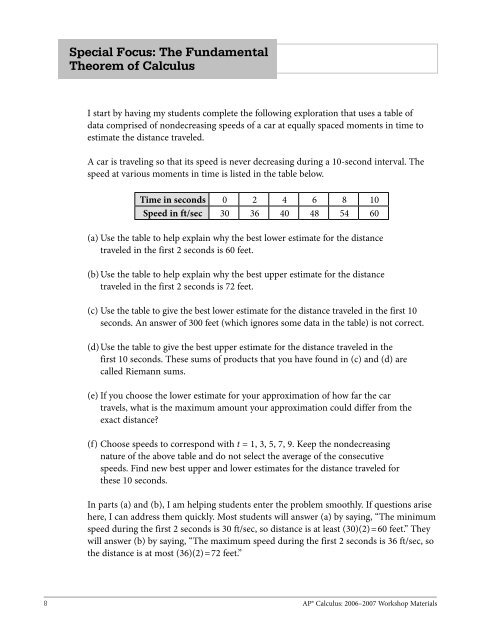AP Calculus
You also want an ePaper? Increase the reach of your titles
YUMPU automatically turns print PDFs into web optimized ePapers that Google loves.
Special Focus: The Fundamental<br />
Theorem of <strong>Calculus</strong><br />
I start by having my students complete the following exploration that uses a table of<br />
data comprised of nondecreasing speeds of a car at equally spaced moments in time to<br />
estimate the distance traveled.<br />
A car is traveling so that its speed is never decreasing during a 10-second interval. The<br />
speed at various moments in time is listed in the table below.<br />
Time in seconds 0 2 4 6 8 10<br />
Speed in ft/sec 30 36 40 48 54 60<br />
(a) Use the table to help explain why the best lower estimate for the distance<br />
traveled in the first 2 seconds is 60 feet.<br />
(b) Use the table to help explain why the best upper estimate for the distance<br />
traveled in the first 2 seconds is 72 feet.<br />
(c) Use the table to give the best lower estimate for the distance traveled in the first 10<br />
seconds. An answer of 300 feet (which ignores some data in the table) is not correct.<br />
(d) Use the table to give the best upper estimate for the distance traveled in the<br />
first 10 seconds. These sums of products that you have found in (c) and (d) are<br />
called Riemann sums.<br />
(e) If you choose the lower estimate for your approximation of how far the car<br />
travels, what is the maximum amount your approximation could differ from the<br />
exact distance?<br />
(f) Choose speeds to correspond with t = 1, 3, 5, 7, 9. Keep the nondecreasing<br />
nature of the above table and do not select the average of the consecutive<br />
speeds. Find new best upper and lower estimates for the distance traveled for<br />
these 10 seconds.<br />
In parts (a) and (b), I am helping students enter the problem smoothly. If questions arise<br />
here, I can address them quickly. Most students will answer (a) by saying, “The minimum<br />
speed during the first 2 seconds is 30 ft/sec, so distance is at least (30)(2)=60 feet.” They<br />
will answer (b) by saying, “The maximum speed during the first 2 seconds is 36 ft/sec, so<br />
the distance is at most (36)(2)=72 feet.”<br />
8<br />
<strong>AP</strong>® <strong>Calculus</strong>: 2006–2007 Workshop Materials


